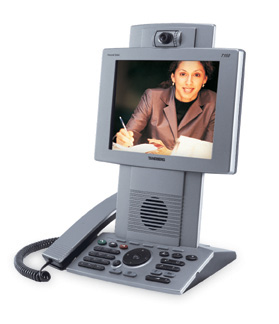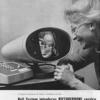 It appears the new Cisco IP Phone 7985G Videophone is OEM'ed from Tandberg (image to left which is identical to the image I posted about the Cisco videophone on Friday).
It appears the new Cisco IP Phone 7985G Videophone is OEM'ed from Tandberg (image to left which is identical to the image I posted about the Cisco videophone on Friday).
If the Cisco videophone has the same feature-set as the Tandberg 150 MXP, then it does indeed support SIP, which I was unsure about when I broke the story on the new Cisco videphone. In fact, the Tandberg 150 MXP also supports the H.323 protocol as well, which is a plus since many legacy videophone systems from Polycom and other manufacturers support H.323. I wonder if Cisco also added their SKINNY protocol to the phone? That would make it 3 protocols running on the Cisco videophone.
According to Tandberg's website the Tandberg 150 MXP has the following features, which I assume the Cisco phone will have as well:
• Optional IM and webconferencing
• URI Dialing
• H.323 & SIP support.
• Up to 512 kbps IP
• Superior video quality incorporating the H.264 standard
• Standards-based embedded encryption (AES & DES)
• Protection against network interruptions with automatic Downspeeding and IPLR
The Tandberg 150 MXP retails for US$2,990, which seems extremely steep to me. I doubt Cisco could get away with selling a business desktop videphone for three thousand dollars. Even high executives such as CEOs aren't going to want to pay $3000 for a desktop phone -that's more than the price of many IP-PBX systems! Just how much margin and markup is on this Tandberg phone that Cisco can still make a few bucks on it? Seems very odd to me that Cisco didn't just build their own videophone. They certainly have the expertise to do this. Further, I would think they could build it less expensively and sell it for much less with a higher profit margin. The only thing I can think of it that this phone is more of a "conference room" videophone and not a desktop videophone for every employee. Certainly today most high-end videoconferencing systems do cost around $3000 so it does fit much better in the conference room videoconferencing space.
Personally, I think Cisco would be better off going after the business desktop videophone space. Let's assume most small to medium corporations have between 1-4 conference rooms. Assuming the max - 4 conference rooms, that's only 4 X $3000 = $12,000 sale per business. Now instead let's assume Cisco makes a desktop videophone that retails for $1000 and assume the average business has 50 employees. Multiple $1000 X 50 = $50,000 sale per business. Of course, not every business is going to need videophones on every single employees desk, but if given the choice between a IP videophone and regular non-video IP phone that is only a few hundred dollars less, many will opt for the more expensive video phones.
Of course, you could simply buy a USB-based high-end $55 Logitech QuickCam Orbit MP Webcam, but until (if?) the PC replaces the desktop phone, we'll still need feature-rich desktop phones.
android apple asterisk at&t blackberry cell phone cisco dell digium e911 facebook fcc google google talk gps im ip-pbx ipad iphone ipod itexpo ITEXPO lync microsoft mobile phone open source outage phone review sip skype sony unified communications verizon video video conferencing voip vonage wireless xbox 360
- Apple (280)
- Bittorrent (2)
- Call Center and CRM (48)
- Computer Hardware (183)
- Computer Software (71)
- Gadgets (650)
- Google (225)
- Home Entertainment (263)
- Internet (173)
- Linux (111)
- Microsoft (376)
- MovableType (48)
- News (187)
- Personal and Humor (118)
- Politics (9)
- Reviews (246)
- Security (2)
- Social Networking (42)
- Sports/Outdoor Technology (9)
- Tablets (32)
- Technology and Science (355)
- Unified Communications (471)
- VoIP (2285)
- Wireless (584)
- p2p (20)
- March 2014
- February 2014
- January 2014
- December 2013
- November 2013
- October 2013
- September 2013
- August 2013
- July 2013
- June 2013
- May 2013
- April 2013
- March 2013
- February 2013
- January 2013
- December 2012
- November 2012
- October 2012
- September 2012
- August 2012
- July 2012
- June 2012
- May 2012
- April 2012
- March 2012
- February 2012
- January 2012
- December 2011
- November 2011
- October 2011
- September 2011
- August 2011
- July 2011
- June 2011
- May 2011
- April 2011
- March 2011
- February 2011
- January 2011
- December 2010
- November 2010
- October 2010
- September 2010
- August 2010
- July 2010
- June 2010
- May 2010
- April 2010
- March 2010
- February 2010
- January 2010
- December 2009
- November 2009
- October 2009
- September 2009
- August 2009
- July 2009
- June 2009
- May 2009
- April 2009
- March 2009
- February 2009
- January 2009
- December 2008
- November 2008
- October 2008
- September 2008
- August 2008
- July 2008
- June 2008
- May 2008
- April 2008
- March 2008
- February 2008
- January 2008
- December 2007
- November 2007
- October 2007
- September 2007
- August 2007
- July 2007
- June 2007
- May 2007
- April 2007
- March 2007
- February 2007
- January 2007
- December 2006
- November 2006
- October 2006
- September 2006
- August 2006
- July 2006
- June 2006
- May 2006
- April 2006
- March 2006
- February 2006
- January 2006
- December 2005
- November 2005
- October 2005
- September 2005
- August 2005
- July 2005
- June 2005
- May 2005
- April 2005
- March 2005
- February 2005
- January 2005
- December 2004
- November 2004
- October 2004
- September 2004
- August 2004
- July 2004
- June 2004
- May 2004
- April 2004
- March 2004
Featured Videos













